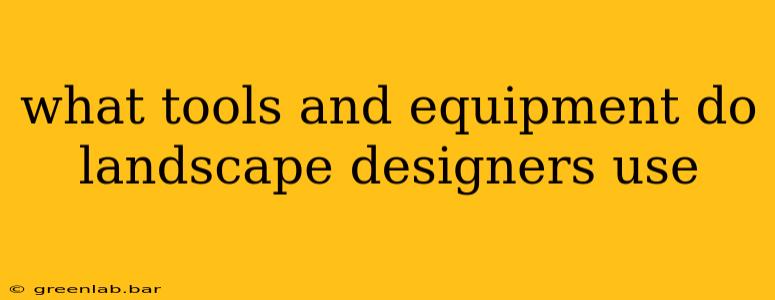Landscape design is a visually driven profession, but it's also deeply rooted in practicality. Creating stunning outdoor spaces requires a blend of artistic vision and technical expertise, and the right tools and equipment are crucial for bringing those visions to life. This guide explores the essential tools and equipment used by landscape designers, from the initial concept phase to the final installation.
I. Design & Planning Stage: Digital Tools Reign Supreme
The initial stages of landscape design are increasingly digital. Sophisticated software allows designers to create detailed plans, renderings, and even virtual walkthroughs.
Essential Software:
- AutoCAD: A cornerstone in architectural and landscape design, AutoCAD provides precision drafting capabilities for creating detailed site plans, elevations, and sections. Its accuracy is paramount for ensuring proper dimensions and construction.
- SketchUp: A user-friendly 3D modeling program, SketchUp allows designers to create visually compelling models of landscapes, experimenting with different plant materials, hardscapes, and features. Its ease of use makes it popular among both beginners and experienced professionals.
- Revit: For larger-scale projects, Revit's building information modeling (BIM) capabilities are invaluable. It allows for greater collaboration and coordination among different design professionals, ensuring a smooth and efficient design process.
- Lumion: This real-time rendering software transforms 3D models into photorealistic images and videos, allowing clients to visualize the final product more effectively. It bridges the gap between design and client understanding.
- Photoshop & Other Image Editing Software: These tools are essential for creating compelling presentations, manipulating images, and integrating photographs into designs for a more realistic portrayal.
II. On-Site Assessment & Measurement: Precision is Key
Before any design can be finalized, a thorough site assessment is essential. This involves careful measurement and observation of the existing conditions.
Essential Equipment:
- Measuring Tape: A long, sturdy measuring tape is essential for accurately measuring distances, areas, and elevations. Consider a wheel-style measuring device for large areas.
- Level: Essential for determining slopes, grades, and ensuring proper drainage. Both a standard level and a laser level (for larger areas) are beneficial.
- Total Station: For large or complex sites, a total station – a surveying instrument combining the functions of a theodolite, EDM (electronic distance measurement), and data recorder – provides highly accurate measurements and data collection.
- GPS/GNSS Receiver: These tools allow for precise geographic location determination, particularly useful for larger-scale projects requiring accurate mapping and integration with GIS data.
- Camera and Drone (optional): High-quality photographs and aerial photography (using drones) are invaluable for documenting existing conditions, creating before-and-after comparisons, and showcasing the final design.
III. Presentation & Communication: Bringing the Vision to Life
Clearly communicating the design to clients is paramount. Effective presentation tools are essential for conveying the vision and garnering client approval.
Essential Tools:
- Presentation Software (PowerPoint, Keynote): Creating compelling presentations that showcase the design visually is crucial.
- Large-Format Printer: The ability to print high-quality design plans and renderings on large sheets of paper is necessary for review and client meetings.
- Physical Models (optional): For complex projects or clients who appreciate tangible representations, creating scaled physical models can significantly enhance communication.
IV. Installation & Construction Oversight: Practical Tools for On-the-Ground Work
While landscape designers don't typically handle the actual construction, they often oversee the process. Understanding the tools used during installation allows for better communication and problem-solving. This is particularly true when working with contractors.
Tools (relevant to overseeing installation):
- Hand Tools (Shovels, Rakes, etc.): While not always directly used, familiarity with basic gardening and landscaping tools is important for understanding the on-site process.
This comprehensive overview highlights the key tools and equipment used by landscape designers. The specific tools and software utilized can vary depending on the scale and complexity of the project, but the core principles of precision, visual communication, and client understanding remain constant. By employing these tools effectively, landscape designers can transform concepts into breathtaking outdoor spaces.

